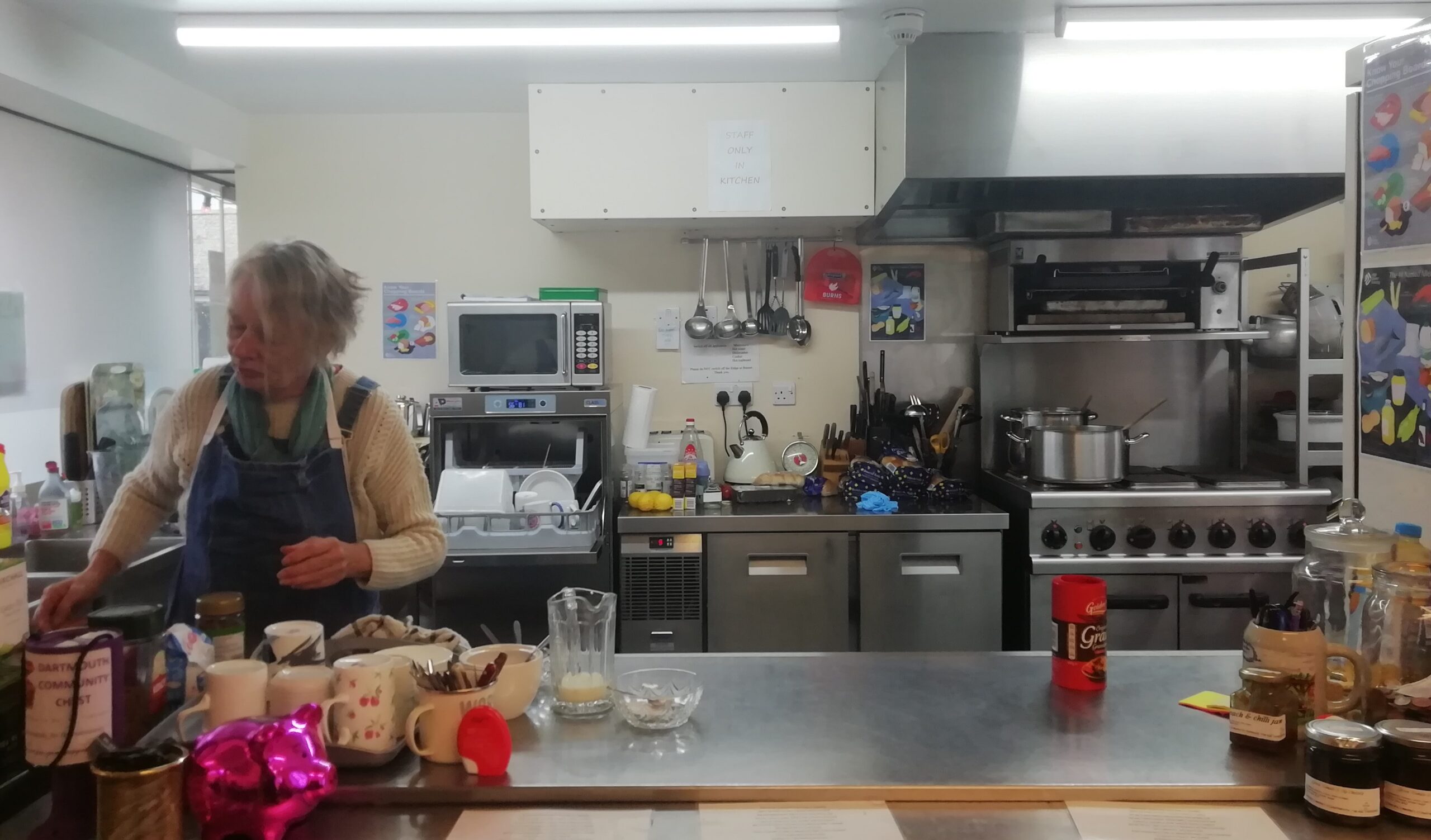Baked potato, coleslaw and a dahl. The first thing Julie tells me is the menu. “We don’t tend to do meat, so the protein is from the lentils in the dahl. You have to get balanced nutrients,” she says.
Culinary creativity
In the UK there’s around 9.5 million tonnes of food waste per year. The Dartmouth Community Cafe, run by Dartmouth Community Chest, takes a fraction of that waste and turns it into warm, friendly and nutritious meals. It’s part of the venue’s offering. At each sitting they can provide 50-60 servings. They don’t know what they will receive, and they don’t know how many people they will actually be catering for. It’s the height of culinary creativity. Through that creativity and craft they are helping address the excessive food waste in the country. And they are using what would have been put into bins to feed people, make connections and connect the community.
The kitchen is calm. The dahl is gently bubbling, the potatoes quietly baking, and the salad waiting, salad-like, to be turned into something exciting.
Julie inhabits the kitchen. As time passes she stirs, assesses, and prepares for dishing up. There is a steady mill of people asking for tea and coffee, to accompany the biscuits and fruit on the tables. Andrew, a volunteer, is on hand ready to refill cups, wipe down tops and share some words.
Balanced and nutritious
A balanced, nutritious meal can be difficult at the best of times, and Julie doesn’t know what she’s going to be cooking until she gets in. Admittedly, she has an idea, but she’s directed by the food that’s diverted from the excess of a local supermarket or donated from one of the food businesses in the town, which is often unknown until they are received.
Food had always been a part of Julie’s life. Back in the day, with a young family she would travel to music festivals providing food for the revellers, along with hot tea and scones to cater for those early morning munchies. When she lived in Cornwall, with an Aga always on, she’d bake bread, construct conserves and all kinds of other creations, for people to pick up what they needed and what took their fancy with an honesty box for their contribution.
Handfuls of skill
In Dartmouth Community Cafe, by identifying and diverting food waste, adding a cup of creativity, handfuls of skill, and a framework of a planning, legwork, imagination and graft, you have a situation where waste becomes warmth. Some of the food insecurity is overcome, and some of the isolation is addressed. It’s not a little daunting.

I mention warmth, that’s because the hot lunchtime meal is part of the winter warm hubs which are offered in the Dartmouth Community Cafe by Dartmouth Community Chest. From October to April, the cafe offers a free, warm meal on Monday, Wednesday and Friday.
But it’s not only in the cafe. Food is taken out to some of the traders in Dartmouth market. It also goes into the food packages that Dartmouth Community Chest delivers. If there are leftovers, Julie takes it back to share with other residents where she lives. When there aren’t leftovers, lunchtime can be a bit stressful, hoping that what they have stretches for everyone.
Everyone is helped
Sylvia, who’s helping out serving, points to the food and hygiene certificates on the wall – a representation of what’s required to work in the kitchen, and a way of increasing the skills, training, experience gained by those volunteering there. She shows me to the discrete food pantry, which has beans, rice, and cereal – basics to keep you going. They combine with the bedding, cutlery, and everything else you need to set up a new place to live. The cafe is a drop-off place for new people in the town who often have nothing. To help them set up, the charity engages in another form of recycling, passing on old and used white goods and furniture, intended for a new home. Although the demand has been so high lately, and with people feeling the pinch, there’s been a shortage, especially of white goods, and especially for people with nothing to exchange.
“Everyone who comes here is helped and pointed in the right direction,” says Sylvia.
The cooking is under control. And that’s the way Julie likes it.
“The training for food and hygiene is online, but working in a kitchen is very different,” she says, highlighting the value of hands-on experience. As well as working at a food wagon at the festivals, Julie was in the kitchen of the Green Dragon, Stoke Fleming, which underlined the order and organisation that’s needed to take charge of a kitchen.
Cooking and sharing
“It’s all about cooking and sharing,” she says. “And with four boys, I’ve learnt to be inventive.”
Andrew helps out in the kitchen every Monday. He had experience in a cafe and puts that to use and builds on it each week.
“It’s like giving a hand to the whole community,” he says. “I like seeing a smile on people’s faces. It is a perfect place to meet new people, you hear so many inspiring stories.” Because the cafe is making allsorts, as he puts it, he has experience of making and tasting a whole range of new flavours.

For Julie, taking on the kitchen has got her cooking and eating again. She doesn’t cook at home after a fire, and PTSD, which manifest as an eating disorder. She’s keen that information about nutrition and the benefits of eating well are shared.
Delicious
In case stocks are short on any given day, there’s always a Plan B. The freezer has a reserve of staples for stews and soups, and to cater some of the many events that come out of the cafe. In part of the perfectly balanced planning that is put into practice.
Even as lunch is being dished up, Julie’s mind is whirling towards the next meal. She’s excited, a local greengrocer has a bag of misshapen parsnips to share. Who knew that such a sparkle could be inspired by parsnips?
(PS… the dahl was delicious!)

